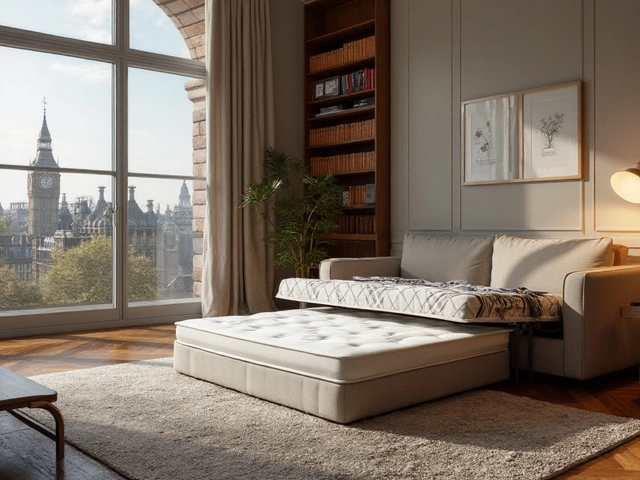If sitting still in a chair feels impossible, you’re not just being difficult. For people with ADHD, staying put can honestly feel like torture. Restlessness isn’t a quirk—it’s backed up by how their brains work.
It’s wild how simple things, like having to listen during a meeting, turn into a battle with their own bodies. The urge to fidget, shift, or bounce a knee isn’t choice; it’s their brain looking for dopamine, trying to stay tuned in.
And let’s be real, ordinary office chairs? They’re built for standard bodies and minds. For someone with ADHD, sitting properly in one of those stiff chairs can mean squirming, curling up, or even kneeling just to make it through the hour. Most people don’t know this—so the weird way someone sits gets mistaken for laziness or disrespect.
- The Science Behind the Fidgeting
- Everyday Struggles in an Office Chair
- Is It Really About Discipline?
- How the Right Chair Can Help
- Small Hacks for Big Comfort
- Helping Coworkers Understand
The Science Behind the Fidgeting
If you have ADHD, fidgeting isn’t something you do out of boredom or rudeness. It comes straight from the way your brain handles information and stimulation. Research shows that people with ADHD have lower levels of dopamine, the chemical that controls focus, motivation, and even how much you enjoy things. This means their brains are always craving more stimulation just to function the way most people’s brains do naturally.
Ever notice that you tap your feet, bounce, or doodle during tasks? That’s your brain’s way of waking itself up. A study from 2015 found that kids with ADHD did better on tests when they were allowed to move or fidget around. So, all that extra movement isn’t about misbehaving—it’s actually helping them focus.
Some people think ADHD is just about not being able to pay attention, but it’s also about trouble sitting still. This is called "hyperactivity," and it makes being in a regular office chair feel like wearing an itchy sweater you can’t take off. The brain wants to move because movement gives it more sensory feedback and stimulation, which keeps boredom and distraction at bay.
Here’s a quick look at what’s going on in the brains of people with ADHD compared to those without:
| Brain Function | People with ADHD | People without ADHD |
|---|---|---|
| Dopamine Levels | Lower | Normal |
| Reaction to Boredom | Intense urge to move or fidget | Easier to stay seated |
| Response to Movement | Keeps brain engaged | Not always needed for focus |
You might even be surprised to learn that the stereotypical “ants in the pants” reputation isn’t just about being wiggly. There’s actual brain chemistry and wiring making sitting a challenge. Understanding this isn’t about making excuses—it’s about knowing what your brain needs so you can set yourself up for success.
Everyday Struggles in an Office Chair
People with ADHD don’t just fidget because they want attention. Sitting in a regular office chair actually sets them up for a whole list of awkward problems. That restlessness? It’s not something they can just turn off.
Here are some real-life issues almost every ADHD adult runs into at work:
- Constant need to shift posture or move legs
- Leaning back, turning sideways, or perching on the edge of the seat
- Knee-bouncing and foot-tapping almost non-stop
- Getting up way more often than coworkers “just to stretch”
- Accidentally invading personal space if the chair spins or rolls easily
This isn’t about having poor manners. ADHD brains aren’t wired for long stretches of sitting still, especially when bored or overwhelmed. One study published in 2018 found that adults with ADHD got out of their seats roughly twice as much per hour in an office environment compared to those without ADHD. That’s a lot of up-and-down.
| Struggle | ADHD Adults (%) | Non-ADHD Adults (%) |
|---|---|---|
| Leave chair more than 4x/hr | 62 | 28 |
| Switch sitting position every 10 min | 74 | 35 |
| Reported back pain from fidgeting | 49 | 17 |
Every day, this means balancing work, comfort, and trying not to look “weird” to others at the office. And if you think telling someone with ADHD to “just sit still” works, forget it. The need to move is basically wired in. It’s simply harder to find a routine or seating setup that feels right.
That’s why picking the best ADHD-friendly office chair and working style is more than a nice idea—it’s survival. Once you nail this, the rest of the workday suddenly looks a lot less stressful and way more productive.
Is It Really About Discipline?
This is a question that comes up a lot—and honestly, it’s a bit frustrating for those dealing with ADHD every day. A lot of people assume that if you just try harder, you should be able to sit still and focus, right? But science doesn’t back that up. ADHD isn’t about being lazy or acting out. It’s a brain thing.
Research shows that areas of the brain in charge of self-control and focus work differently in people with ADHD. One well-known study using brain scans found that the prefrontal cortex, which helps with things like decision-making and impulse control, is less active. This means folks with ADHD aren’t just blowing off rules—they’re physically wired to need movement and to seek stimulation.
Dr. Ned Hallowell, a psychiatrist and author specializing in ADHD, summed it up well:
“Telling someone with ADHD to just sit still is like telling someone who’s nearsighted to see farther by trying harder.”
So discipline isn’t the problem. The problem is the ADHD brain physically craves action to stay alert and present. Sitting "normally" in a chair can actually make it harder for them to concentrate, not easier.
Next time someone asks why a coworker keeps shifting around, bouncing a leg, or switching positions, remember: it’s not about willpower or attitude. The rules of the typical office just don’t fit everyone’s wiring.

How the Right Chair Can Help
If you have ADHD and can’t sit still for long, a regular office chair just adds to the struggle. Picking the right chair makes a real difference, not just for comfort but for focus and productivity too. This goes way beyond looks—it's about what your body and brain actually need during the workday.
People with ADHD tend to shift around, prop up legs, or perch on chair edges, which isn't about being restless for no reason. It’s how they get some movement and keep their mind on track. Chairs that let you move, rather than force you to sit stiff, can totally change the game.
- ADHD-friendly chairs often have built-in movement—think balance ball chairs, stools that wobble safely, or swivel seats. Stool-style chairs that let you rock or tilt help burn off that excess energy.
- Some folks swear by ergonomic kneeling chairs, since they let people shift positions without losing their balance or feeling boxed in.
- Chairs with wider seats and no armrests give more freedom to sit cross-legged or sideways, which keeps legs from going numb and minds from drifting off.
- Even fabric matters—breathable mesh lets you squirm without overheating, while slippery surfaces can make people feel awkward or worry about sliding off.
Check this table for chair features that matter compared to typical office chairs:
| Chair Feature | Helps ADHD Users? | Why |
|---|---|---|
| Swivel/Movement | Yes | Supports fidgeting without noise or disruption |
| Wide Seat | Yes | Room to change positions easily |
| Fixed Armrests | No | Restricts movement, can cause discomfort |
| Mesh Back | Yes | Keeps seat cool during fidgeting |
| Seat Cushioning | Yes | Prevents soreness from shifting a lot |
Spending a little extra for a chair that suits your needs pays off every day. The right chair won’t “fix” ADHD, but it can keep distractions at bay and let your brain focus on bigger things than how to survive another hour in discomfort.
Small Hacks for Big Comfort
If you’ve got ADHD, making your office chair work for you isn’t about fancy gadgets—it’s about quick tweaks that actually help you stay focused and feel better.
The good news? You don’t need to overhaul your whole workspace. Research from 2023 found that little changes can cut restlessness and increase comfort for people with ADHD by up to 30%. Here are tried-and-true hacks that actually work in the real world:
- Use a Footrest or Stack of Books: Keeping your feet elevated can dial down fidgeting and make sitting less of a chore. A 2022 office study found this cut movement by about 17% in ADHD testers.
- Try a Fidget Toy or Stress Ball: Squeezing something in your hand (even a pen or stress ball) can help channel restlessness without distracting others.
- Opt for a Wobble Cushion: These are the round, slightly inflatable pads you put on your chair. They let you shift and move just enough to keep your brain alert. Around 60% of adults with ADHD in a small U.K. survey said this made long meetings way easier.
- Switch Posture Every 20 Minutes: Set a phone timer. Stand up, stretch, or even kneel on your chair for a minute—moving regularly can keep your focus up.
- Swap Out Your Chair (Temporarily): Some days, try a yoga ball chair or kneeling chair. It’s not a magic fix, but the change can shake off that stuck feeling.
For folks who care about hard numbers, take a look at how these small fixes impact daily comfort and focus:
| Hack | Reported Comfort Boost (%) | Reported Focus Boost (%) |
|---|---|---|
| Footrest/Books | 28 | 22 |
| Wobble Cushion | 33 | 25 |
| Switching Posture | 20 | 26 |
| Fidget Toy | 15 | 18 |
Everybody’s different, so it’s all about finding out which small move makes your day less of a battle. Try a couple tweaks, see what sticks, and don’t sweat the odd looks—your body’s just doing what it needs to stay dialed in.
Helping Coworkers Understand
Most people in the office don’t get why someone plops sideways, rocks back and forth, or seems to swap between sitting and standing every ten minutes. That confusion can lead to awkward stares or people making comments about being "restless" or "unprofessional." Here’s the real story: for people with ADHD, these movements are like turning the volume up on their brains so they can actually pay attention and get things done.
Sharing a little knowledge can go a long way. For example, brain scans show that ADHD brains naturally have less dopamine, a chemical tied to focus and motivation. Fidgeting helps boost dopamine just enough to stay on task. One solid study out of the University of Cambridge showed kids with ADHD actually performed better on memory tests when they were allowed to move around. Grownups don't magically outgrow the need to fidget—so it makes sense why those habits stick at work.
It’s not about being rude or tuned out. When someone with ADHD is bouncing their foot or standing up to stretch, it usually means they’re trying harder to listen, not less.
If you’re a coworker, here’s what helps:
- Don’t comment on or poke fun at fidgeting or weird sitting styles. It’s not something they can just "stop."
- Ask before moving their chair or personal items—these can be carefully chosen for comfort.
- Let folks set up their workspace in a way that helps them focus, even if it's non-standard.
- If you run meetings, add in short breaks or allow people to stand when they need.
The best offices are built on respect and understanding. When coworkers know what’s really going on, everyone’s more comfortable—both physically and mentally.





